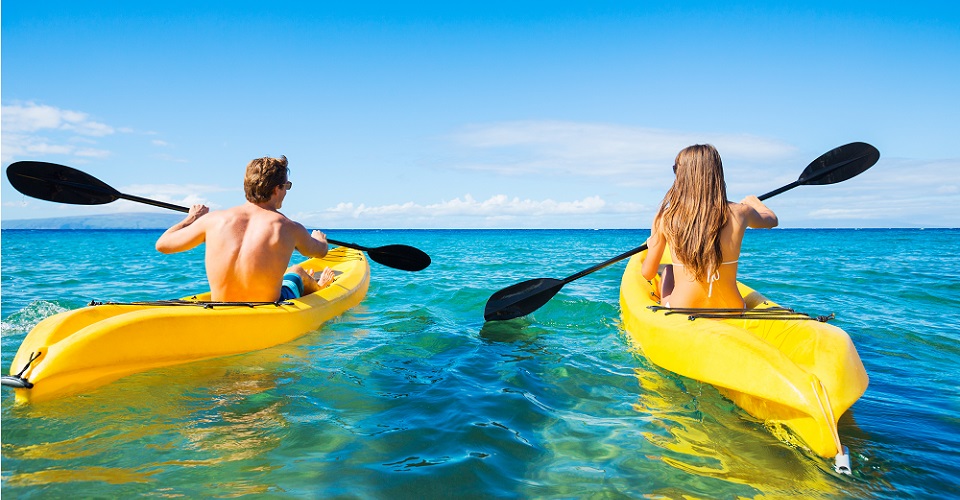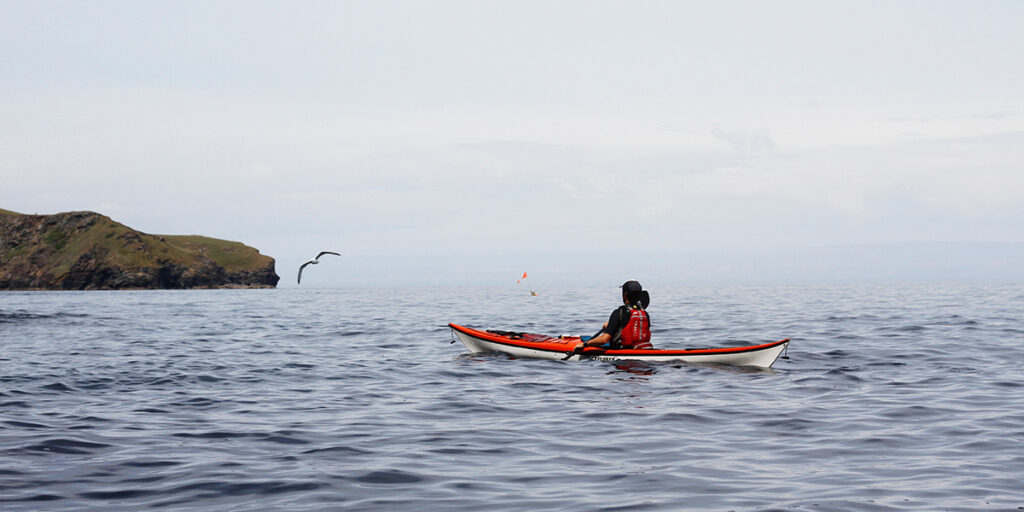Kayaking is an exhilarating water sport that offers a unique opportunity to explore beautiful waterways, commune with nature, and indulge in thrilling adventures.
If you’re considering buying a kayak, one of the key decisions you’ll face is whether to choose a sit-on-top kayak or a sit-in kayak.
Each type has its own set of advantages and considerations, making it important to understand the differences and weigh them against your specific needs and preferences.
It is important to understand this when selecting the right kayak that aligns with your goals and enhances your overall kayaking experience.
In this article, we’ll provide an informative guide to help you make an informed decision when it comes to choosing between sit-on-top and sit-in kayaks.
Whether you’re a beginner or an experienced paddler, researching the pros and cons of each type can make a world of difference in your enjoyment on the water.
We’ll begin by providing an overview of sit-on-top kayaks, delving into their design features, advantages, and limitations.
We’ll then move on to an exploration of sit-in kayaks, highlighting their distinctive characteristics and discussing the benefits and considerations associated with this style.
Finally, we’ll conclude by presenting factors to consider when making your choice and addressing frequently asked questions to address any lingering queries you may have.
By the end of this article, you’ll have a comprehensive understanding of both sit-on-top and sit-in kayaks, empowering you to make an educated decision that aligns with your skill level, intended use, and personal preferences.
Let’s dive in and embark on this informative journey to discover which type of kayak suits you best.
Overview of Sit-on-Top Kayaks
Sit-on-top kayaks have gained significant popularity in the world of kayaking. These kayaks are designed with an open cockpit, providing a comfortable and accessible seating area on top of the kayak’s hull.

Let’s first have a look at the features and benefits that make sit-on-top kayaks a preferred choice for many paddlers.
Definition and Design Features of Sit-on-Top Kayaks
Sit-on-top kayaks, as the name suggests, feature a design where the paddler sits on the top surface of the kayak.
The cockpit is open, allowing for easy entry and exit. These kayaks typically have a wider and more stable hull design compared to sit-in kayaks, making them suitable for various water activities.
Advantages of Sit-on-Top Kayaks
1. Ease of Use, Especially for Beginners
Sit-on-top kayaks are often recommended for beginners due to their user-friendly nature. The open design makes it effortless to get on and off the kayak, eliminating any feelings of confinement.
2. Increased Stability and Buoyancy
The wider hull of sit-on-top kayaks provides excellent stability on the water, making them ideal for beginners or those seeking a stable platform for fishing, snorkeling, or other recreational activities.
The inherent buoyancy of sit-on-top kayaks also adds an extra layer of safety.
3. Self-Bailing Design and Ability to Handle Rough Waters
Sit-on-top kayaks are designed with scupper holes or self-bailing systems that allow water to drain out of the kayak.
This feature ensures that even if water splashes into the kayak, it quickly drains out, keeping the paddler dry and the kayak buoyant.
This design also makes sit-on-top kayaks more suitable for paddling in rougher waters or ocean environments.
4. Accessibility and Freedom of Movement
The open cockpit design of sit-on-top kayaks provides excellent freedom of movement for the paddler.
Whether you want to stretch your legs, swim, or reposition yourself, you can easily do so without any constraints.
Limitations of Sit-on-Top Kayaks
1. Exposure to the Elements and Potential for Getting Wet
Sit-on-top kayaks offer less protection from the elements compared to sit-in kayaks.
Paddlers are more exposed to wind, water splashes, and potentially getting wet. However, this aspect can also be viewed positively by those who enjoy the refreshing feeling of being in direct contact with the water.
2. Less Efficient Paddling Compared to Sit-in Kayaks
Due to the design and higher profile, sit-on-top kayaks may require more effort to paddle compared to sit-in kayaks.
The wider hulls can create more drag, resulting in reduced speed and efficiency. However, for leisurely recreational paddling or engaging in water activities, this may not be a significant concern.
3. Limited Storage Space and Reduced Speed
Sit-on-top kayaks usually have limited storage capacity compared to sit-in kayaks.
This can be a consideration if you plan to carry a lot of gear or embark on longer expeditions.
Additionally, the wider hulls may contribute to a slightly slower speed compared to narrower sit-in kayaks designed for speed and performance.
Overall, sit-on-top kayaks offer a range of advantages such as ease of use, stability, self-bailing capabilities, and freedom of movement.
These factors make them an excellent choice for beginners, casual paddlers, and those who prioritize comfort and accessibility over speed and storage capacity.
Overview of Sit-in Kayaks
Sit-in kayaks are another popular option in the world of kayaking. These kayaks feature a closed cockpit design, where the paddler sits inside the kayak’s hull.

Let’s explore the design features and benefits that make sit-in kayaks a preferred choice for certain paddlers.
Definition and Design Features of Sit-in Kayaks
Sit-in kayaks are designed with a cockpit that allows the paddler to sit inside the kayak, with their legs positioned beneath the deck.
The cockpit is enclosed, providing a sense of being “in” the kayak rather than on top of it. This design offers distinct advantages and features worth considering.
Advantages of Sit-in Kayaks
1. Improved Protection from the Elements
The enclosed cockpit of sit-in kayaks provides better protection against wind, water splashes, and the elements in general.
The deck skirt or spray skirt can be used to create a barrier, keeping water out of the cockpit and enhancing comfort in colder weather conditions.
2. Enhanced Paddling Efficiency and Speed
Sit-in kayaks often have a narrower and more streamlined hull design, allowing for efficient paddling and improved speed.
The lower profile and reduced drag contribute to smoother and swifter movements through the water, making them suitable for longer expeditions or those who prioritize speed.
3. Increased Storage Capacity for Gear
Sit-in kayaks typically offer more storage space compared to sit-on-top kayaks.
The enclosed hull provides dry storage compartments, allowing paddlers to carry equipment, supplies, and personal belongings without the risk of getting them wet or exposed to the elements.
4. Suitability for Colder Weather Conditions
The enclosed cockpit of sit-in kayaks provides additional protection and insulation, making them a preferred choice for paddling in colder climates or during colder seasons.
The ability to use a spray skirt helps to further seal off the cockpit from cold water and wind.
Limitations of Sit-in Kayaks
1. Learning Curve for Beginners:
Sit-in kayaks require some practice and skill development, especially for beginners who are not familiar with the enclosed cockpit design.
The process of getting in and out of the kayak and mastering the use of a spray skirt may take some time to become comfortable and proficient.
2. Reduced Stability, Especially for Novice Paddlers
Sit-in kayaks, particularly those with narrower hulls, tend to have a slightly higher learning curve when it comes to stability.
Novice paddlers may initially find it more challenging to maintain balance compared to the wider and more stable sit-on-top kayaks.
3. Potential Difficulty in Self-Rescue Situations
In the event of a capsize or self-rescue situation, sit-in kayaks require specific techniques to re-enter the kayak or perform a roll.
These techniques generally require additional training and practice compared to sit-on-top kayaks, which offer a more straightforward re-entry process.
Sit-in kayaks offer advantages such as improved protection from the elements, enhanced paddling efficiency, increased storage capacity, and suitability for colder weather conditions.
These factors make them an excellent choice for paddlers who prioritize performance, longer expeditions, and a desire for added protection and storage capabilities.
While there may be a learning curve and considerations for stability and self-rescue, sit-in kayaks can provide a rewarding experience for those willing to invest the time and effort in developing their skills.
Factors to Consider When Choosing Between Sit-on-Top and Sit-in Kayaks
When it comes to selecting the right kayak for your needs, it’s essential to consider various factors that can influence your decision.
Here are some key considerations to help you choose between sit-on-top and sit-in kayaks:
A. Skill Level and Experience of the Paddler
Consider your level of experience and skill in kayaking. Sit-on-top kayaks are generally more beginner-friendly, offering stability and ease of use, making them suitable for novices.
If you’re new to kayaking or prefer a hassle-free experience, a sit-on-top kayak might be the better choice.
On the other hand, if you have intermediate to advanced skills, enjoy maneuverability, and are willing to invest time in learning proper techniques, a sit-in kayak could be a rewarding option.
B. Intended Use and Water Conditions
Think about the type of paddling you plan to do and the environments you’ll encounter. Sit-on-top kayaks excel in recreational activities such as fishing, snorkeling, or casual paddling on calm waters.
They are well-suited for warm climates and locations where water splashes and self-bailing capabilities are beneficial.
Sit-in kayaks, with their speed and efficiency, are more suitable for touring, longer expeditions, and paddling in various water conditions, including lakes, rivers, and even mild coastal areas.
C. Personal Preferences and Comfort
Consider your personal preferences and comfort requirements. Some paddlers prefer the open feel and freedom of movement provided by sit-on-top kayaks, while others appreciate the enclosed cockpit and the sense of being “in” the water with a sit-in kayak.
Additionally, consider factors like seat comfort, legroom, and the ability to stretch or adjust your seating position during longer paddling sessions.
D. Storage and Transportation Considerations
Evaluate your storage and transportation needs. Sit-on-top kayaks are generally easier to transport due to their lighter weight and less complex design.
They can be carried on car roof racks or stored in smaller spaces.
Sit-in kayaks, with their longer and narrower profile, may require specialized racks or trailers for transport, and they often demand more storage space due to their length.
E. Budget and Cost of the Kayak
Consider your budget and the cost of the kayak, including any additional accessories you may need. Sit-on-top kayaks tend to be more budget-friendly and offer good value for beginners or recreational paddlers.
Sit-in kayaks, especially those designed for touring or performance, may be pricier due to their construction and advanced features.
Determine your budget range and choose a kayak that fits within it while still meeting your requirements.
Ultimately, the choice between a sit-on-top or sit-in kayak depends on your specific needs, preferences, and intended use.
Take the time to assess your skill level, consider the water conditions you’ll encounter, evaluate your comfort requirements, factor in storage and transportation considerations, and stay within your budget.
By doing so, you can make an informed decision that will enhance your kayaking experience and ensure that you select the kayak that aligns best with your goals and aspirations.
Conclusion
Choosing between a sit-on-top and sit-in kayak is a decision that should be based on careful consideration of your individual needs, preferences, and intended use.
Both types of kayaks offer unique advantages and limitations that can greatly impact your overall kayaking experience.
Sit-on-top kayaks excel in ease of use, stability, self-bailing capabilities, and accessibility, making them ideal for beginners, casual paddlers, and those who prioritize comfort and recreational activities.
They provide a fun and hassle-free option for enjoying the water and engaging in various water-based adventures.
Sit-in kayaks, on the other hand, offer improved protection from the elements, enhanced paddling efficiency, increased storage capacity, and suitability for longer expeditions and performance-oriented paddling.
They are favored by intermediate to advanced paddlers who value speed, maneuverability, and the ability to tackle different water conditions.
When making your decision, consider factors such as your skill level, intended use, personal comfort preferences, storage and transportation requirements, and budget.
It’s also worth noting that trying out both types of kayaks, if possible, can provide valuable hands-on experience to help inform your decision.
Regardless of the type of kayak you choose, remember that kayaking offers a world of adventure, exploration, and enjoyment.
The key is to select the kayak that aligns with your goals and aspirations, and to embrace the joy and excitement that comes with immersing yourself in the wonders of the water.
So, whether you opt for the open and accessible nature of a sit-on-top kayak or the efficiency and performance of a sit-in kayak, get ready to embark on unforgettable journeys, discover hidden waterways, and create lasting memories in the captivating world of kayaking.
FAQ
Q: Can I use a sit-on-top kayak if I’m a beginner?
A: Absolutely! Sit-on-top kayaks are often recommended for beginners due to their user-friendly nature. They provide excellent stability, easy entry and exit, and a forgiving design that makes them a great choice for those new to kayaking.
Q: Are sit-in kayaks more suitable for advanced paddlers?
A: Sit-in kayaks can be a good fit for advanced paddlers who have developed their skills and want to prioritize performance and efficiency. The narrower hull design allows for faster speeds and better maneuverability, making them ideal for longer expeditions and varied water conditions.
Q: Will I get wet in a sit-on-top kayak?
A: Yes, sit-on-top kayaks are designed with an open cockpit, which means you may get wet from water splashes. However, many paddlers enjoy this aspect as it provides a refreshing and immersive experience, especially in warm weather.
Q: Are sit-in kayaks more difficult to enter and exit?
A: Sit-in kayaks do have a learning curve when it comes to getting in and out of the enclosed cockpit. However, with practice and proper technique, entering and exiting a sit-in kayak becomes more comfortable. Using a spray skirt can help create a seal and enhance the experience.
Q: Can I use a sit-on-top kayak for longer trips?
A: While sit-on-top kayaks offer limited storage space compared to sit-in kayaks, they can still be used for shorter overnight trips or day trips. However, if you plan to carry a significant amount of gear or go on extended expeditions, a sit-in kayak with its increased storage capacity might be more suitable.
Q: Are sit-in kayaks more expensive than sit-on-top kayaks?
The cost of kayaks can vary depending on the brand, materials used, and features offered. In general, sit-in kayaks, especially those designed for touring or performance, may be slightly more expensive compared to sit-on-top kayaks. However, there are affordable options available in both categories to suit different budgets.
Q: Can I try both types of kayaks before making a decision?
A: Yes, if possible, it’s highly recommended to try both sit-on-top and sit-in kayaks before making a decision. This hands-on experience will help you determine which type feels more comfortable and suits your paddling style and preferences.
Remember, the choice between sit-on-top and sit-in kayaks ultimately depends on your individual needs, skill level, intended use, and personal preferences.
Consider these factors carefully to make an informed decision and enjoy the thrilling adventures that await in the world of kayaking.
Share with us your experiences what type of kayak you prefer…



